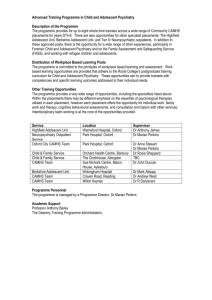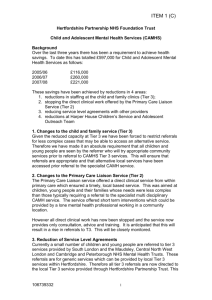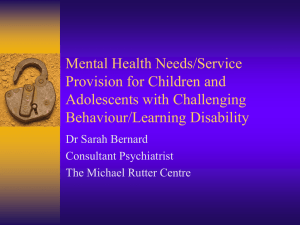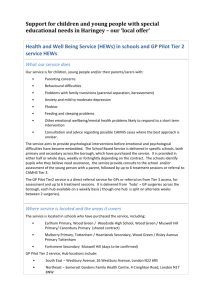The National CAMHS review - Royal College of Psychiatrists
advertisement
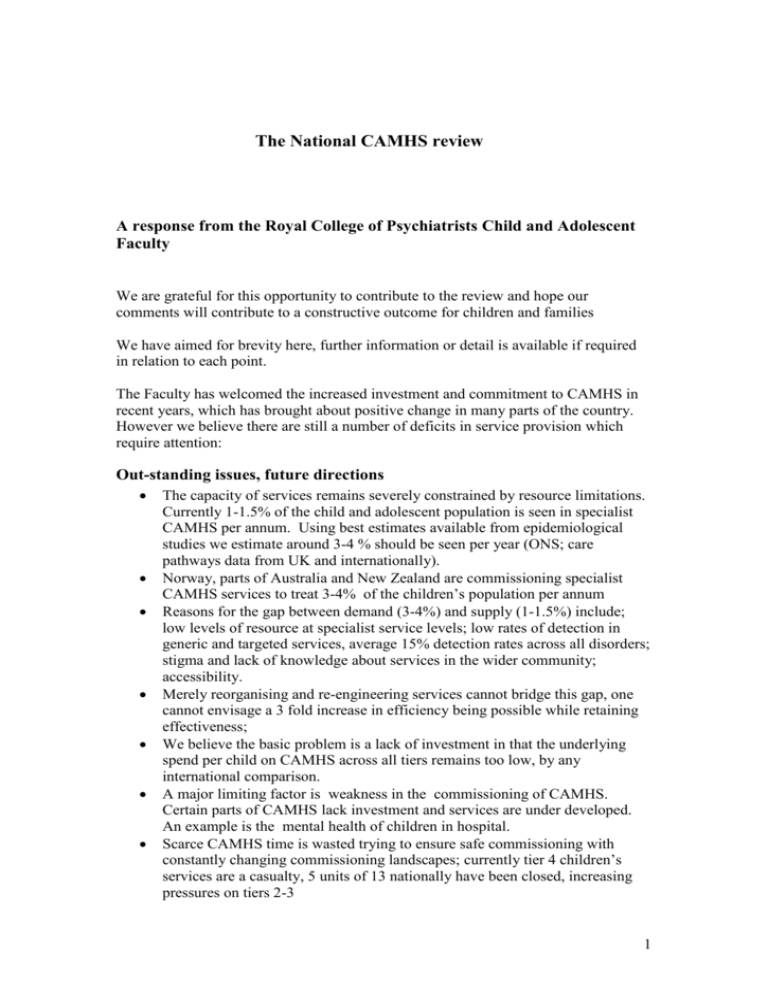
The National CAMHS review A response from the Royal College of Psychiatrists Child and Adolescent Faculty We are grateful for this opportunity to contribute to the review and hope our comments will contribute to a constructive outcome for children and families We have aimed for brevity here, further information or detail is available if required in relation to each point. The Faculty has welcomed the increased investment and commitment to CAMHS in recent years, which has brought about positive change in many parts of the country. However we believe there are still a number of deficits in service provision which require attention: Out-standing issues, future directions The capacity of services remains severely constrained by resource limitations. Currently 1-1.5% of the child and adolescent population is seen in specialist CAMHS per annum. Using best estimates available from epidemiological studies we estimate around 3-4 % should be seen per year (ONS; care pathways data from UK and internationally). Norway, parts of Australia and New Zealand are commissioning specialist CAMHS services to treat 3-4% of the children’s population per annum Reasons for the gap between demand (3-4%) and supply (1-1.5%) include; low levels of resource at specialist service levels; low rates of detection in generic and targeted services, average 15% detection rates across all disorders; stigma and lack of knowledge about services in the wider community; accessibility. Merely reorganising and re-engineering services cannot bridge this gap, one cannot envisage a 3 fold increase in efficiency being possible while retaining effectiveness; We believe the basic problem is a lack of investment in that the underlying spend per child on CAMHS across all tiers remains too low, by any international comparison. A major limiting factor is weakness in the commissioning of CAMHS. Certain parts of CAMHS lack investment and services are under developed. An example is the mental health of children in hospital. Scarce CAMHS time is wasted trying to ensure safe commissioning with constantly changing commissioning landscapes; currently tier 4 children’s services are a casualty, 5 units of 13 nationally have been closed, increasing pressures on tiers 2-3 1 A reprioritisation of children and CAMHS in commissioning could change this, ring-fencing funds, consistent organisations not constant change It is not feasible that simply investing more in tier 1 or 2 services will solve this problem. Tier 1 and 2 need capacity, knowledge and skills investment, for sure as they need to see milder to moderate cases/disorders (probably 6-7% of the child population) alongside those who don’t yet have a disorder, probably another 10% and then select and refer the 3-4% who require specialist treatment in tiers 3-4 More staff with more skills in generic and targeted services will detect more cases and pick up complexity and severity sooner. Increased detection at Tiers 1 and 2 place demand on Tiers 3 and 4 for training, consultation and supervision, not simply increasing case referrals. A focus on efficiency i.e. spreading resources more thinly, will result in a loss of effectiveness of interventions and result in higher over all costs to other parts of the economy. There is evidence to support this assertion, and user/carer demands and NICE guidelines press in the opposite direction. Year on year growth in investment over a 10 to 20 year period could redress the shortfall; for example aiming for real terms growth in capacity of 7-10% per annum. We are concerned that a focus on early intervention not be at the expense of investment in specialised services with academic links whose role is to facilitate development and dissemination of the treatments CAMHS delivers (for example, the Newcastle Autism service which has been decommissioned as ‘no longer necessary’ because these services are now available at Tiers 2 and 3, which fails to recognise the centre that developed them). While of course argument can be ranged against such a growth in specialist services we would see it as part of a comprehensive rethink on children’s wellbeing and point the review once more to our very poor international comparative ratings for both investment and outcomes in kids, UNICEF/drugs/pregnancy/violence Pressure points In the last 10 years the UK population has increased by 10%-15% The prevalence of child & adolescent mental disorder in the UK has increased by between 70-100% in the last 25 years (Maughan et al 2005) along with increased severity, complexity and risk of presentations. Many more children with complex difficulties remain in their communities. Social care beds and residential schools used to take children with complex difficulties. Children remaining with their families is a good thing but it means that the level of provision needs to increase in line with this policy direction. The policy of inclusion of children in difficulty in mainstream education settings needs the resource to support it including early effective recognition and management; this is often missing and leaves other children adversely effected in their learning and development, an adverse ‘ripple effect’ of trauma, hurt, disruption and loss We are near the bottom of UNICEF league tables on children’s mental wellbeing, teenage drug use and pregnancy rates 2 Unfortunately, more recently there is evidence of a standstill or indeed decreases in the CAMHS workforce. Up to 75% of services in a college survey report no change or a decrease in workforce and funding for tiers 2-4 since 2006; losses to Cost Reduction Efficiency Savings/CIPs around the country have been particularly noted. Appendix 1: Action on the determinants of children’s and family’s mental health and wellbeing Continued step changes in mental health services (tiers 1-4) would be welcome and necessary but they will not be sufficient to stem the current negative flux of children and adolescents mental wellbeing. We can help those with disorders and achieve successes in primary prevention e.g. in infant mental health services (these also require access to a high level of expertise from tier 2-4), changes in schools and so forth and we can prove our effectiveness and efficacy for many conditions The emotional wellbeing of children is "everybody's business". Core CAMHS is one quite small part of this but we have daily experience and some empirical data to support the importance of attending to policy and legislation in the way proposed herein. So, taking a really broad national perspective we would like to propose a step change in the priority given to thinking about children, adolescents and family wellbeing…… We recommend a reprioritisation of children& families at a national policy level This could be achieved by creating a requirement that all legislation and policy must consider its impact on the well being of infants, children, adolescents and families before being enacted. The fiscal cost of negative impacts should be considered including long term costs accruing of mental ill health in young people This could be achieved by a ‘National Children’s Advocacy Council and expert group which would advise legislative and policy makers, using evidence, to influence change If there is doubt that this is possible then Finland provides an example of just such a process (personal communication with Professor in Helsinki) Some examples of what is meant here: cycle paths in all new housing development and road building; much more stringent control of foods, additives, labelling and advertising direct to children, open spaces and sporting facilities in all communities; public transport policy, to encourage more social interaction and environmentally friendly; more consideration of the developmental and social impact of parents being actively encouraged by fiscal and other legislation to leave their children from early in life; the collapse of NHS dentistry further marginalises the children of the poor, and so forth, many other examples are possible 3 What is good for young peoples development will be good for the population as a whole, all ages, by both fiscal and health measures Appendix 2: National Survey of Consultant Child & Adolescent Psychiatrists: Tiers 2-4 Attached are the results of a National Survey of Consultant Child & Adolescent Psychiatrists conducted by the Faculty Executive of the Royal College of Psychiatrists Aim: To provide a ‘direct from the coal face snapshot’, evidence of current service circumstances across England in CAMHS Sampling time frame: 5 weeks from 3rd week of May to 26th June 2008 Survey Results (see attachment folder called ‘National Survey Results’) The whole survey (n = 147) Tiers for England only (n = 116 for tier 2-4) as the review refers to England, We could provide the same also for responses from the other nations ( n = 31) There are 3 PDFs Summaries of responses to the survey (%) 1 is the overall summary of responses (n = 147) 1 is for tier 4 England only (n = 27) 1 is for tier 2/3 England only (n = 89) Then 2 word files, containing all the free text comments made separately listed but anonymous 1 is for Tier 4 England ( n = 17) 1 is for Tier 2/3 England ( n= 65) Representativeness of the samples An estimate is that each tier ‘2/3 response’ should represent around 4 consultants taking an average tier 2/3 service as having 4 consultants. So we could say 89 x 4 = 356 That we have here about 356 consultants represented in England tier 2/3. If there are in total around 570 consultants in England tier 2-4 And if we estimate around 60 are in tier 4 then 510 in tier 2-3 4 Then we have 356/510 x 100 = 69.8 % of the English tier 2/3 consultant body represented by this survey. Appendix 3: Cross National European Comparisons of Child and Adolescent Psychiatrists per head of Population of children and adolescents Cross national workforce comparison from the European Society of Child And Adolescent Psychiatry courtesy of Dr. Thomas von Salis (Switzerland). Link http://www.escapnet.org/web/index.php?option=com_content&task=view&id=60&Itemid=143 This table refers to medical workforce only at consultant level but this can be taken as an indicator or marker of overall investment in multidisciplinary CAMHS. In Conclusion We hope this response will be useful in the considerations of the review. We are happy to discuss further. Thank you for you consideration of this submission, Dr Greg Richardson Chair of Faculty of Child and Adolescent Psychiatry Royal College Of Psychiatrists 17 Belgrave Square London SW1 8PG Dr Raphael Kelvin Elected Representative to the Faculty Executive Consultant in Child and Adolescent Psychiatry and Associate Lecturer, Cambridgeshire and Peterborough NHS Foundation Trust & University of Cambridge Professor Simon Gowers Elected Representative to the Faculty Executive Professor of Adolescent Psychiatry, University of Liverpool 04.07.08 5


